
 |
|
Project C10: Modelling,
Asymptotic Analysis and Numerical Simulation | |
| Project head: | Prof. Dr. Barbara Wagner , TU Berlin/WIAS. |
| Support: | Matheon, DFG, Research Center |
| Research Team: | Dr. Dirk Peschka, WIAS (since June 2010) and |
| Dr. Maciek Korzec, TU Berlin (August 2006-April 2011 at WIAS, now TU Berlin) | |
| Former Project Members: | PD Dr. Andreas Münch co-head of the project until September 2008; HU Berlin; now at the Mathematical Insitute, Oxford, U.K. |
| Dr. Peter Evans, HU Berlin until May 2010, now at German Research Center for Geosciences, Potsdam | Publications: | see below |
| Contact: | For further information about this project, please contact Prof. Dr. Barbara Wagner. |
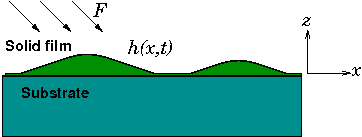
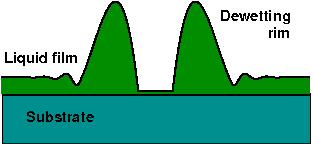
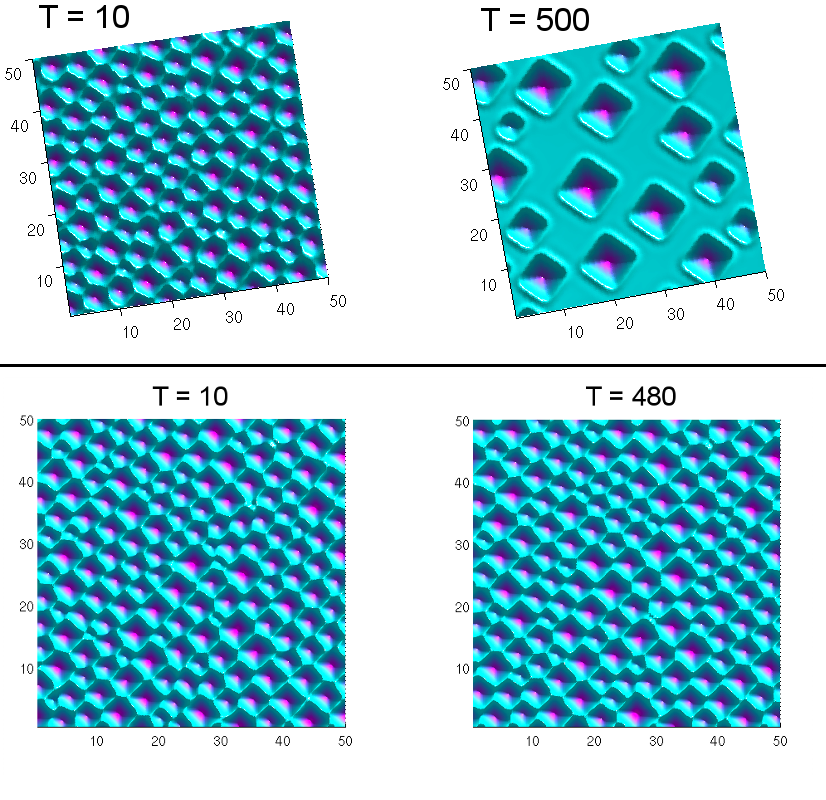 |
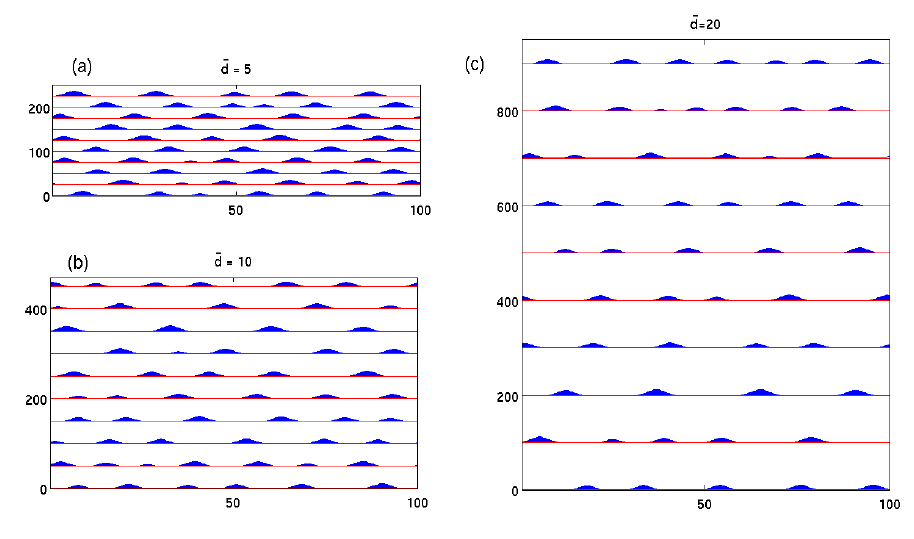 |
|
| Figure 1: Slow down of the coarsening by increasing the anisotropy from (top G=0.5) to (bottom G=1) in numerical simulation [KMW11] | Figure 2: An example of our numerical simulation of stacked quantum dots in 2-D for different spacer thicknesses shows that anti-correlated stacking is observed for the smallest value of the spacer thickness. | |
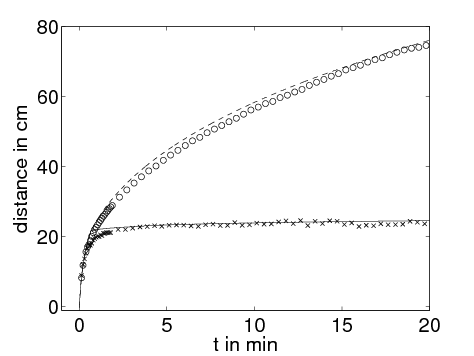 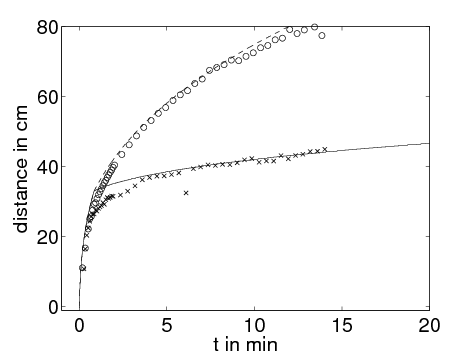 |
| Figure 3: Motion of suspension flow fronts (particles and liquid) on an incline with different inclination angles (left 10deg, right 20deg) and comparison of experiment (symbols) with theory (lines) shows good agreement [MPPB12] |
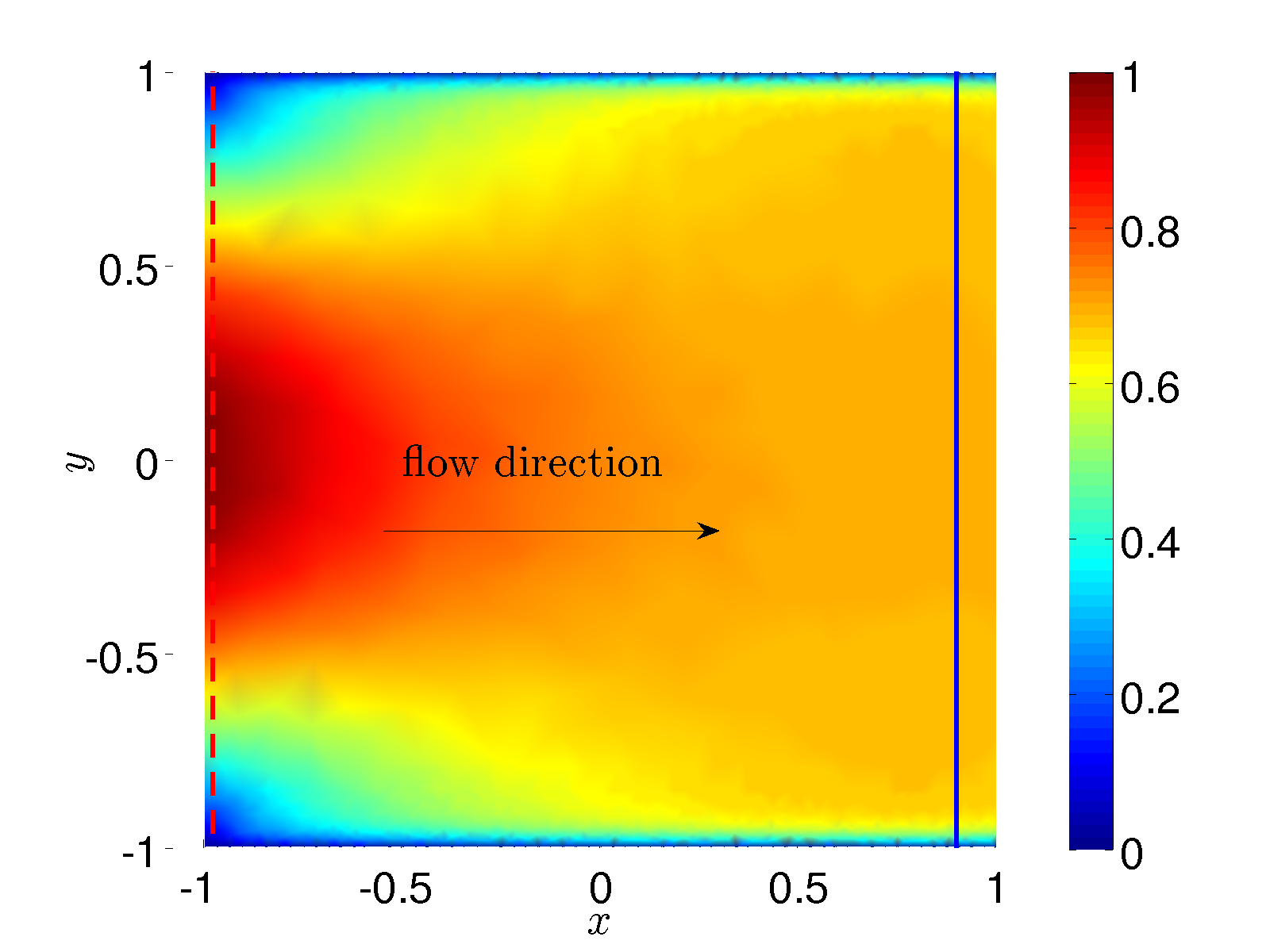 |
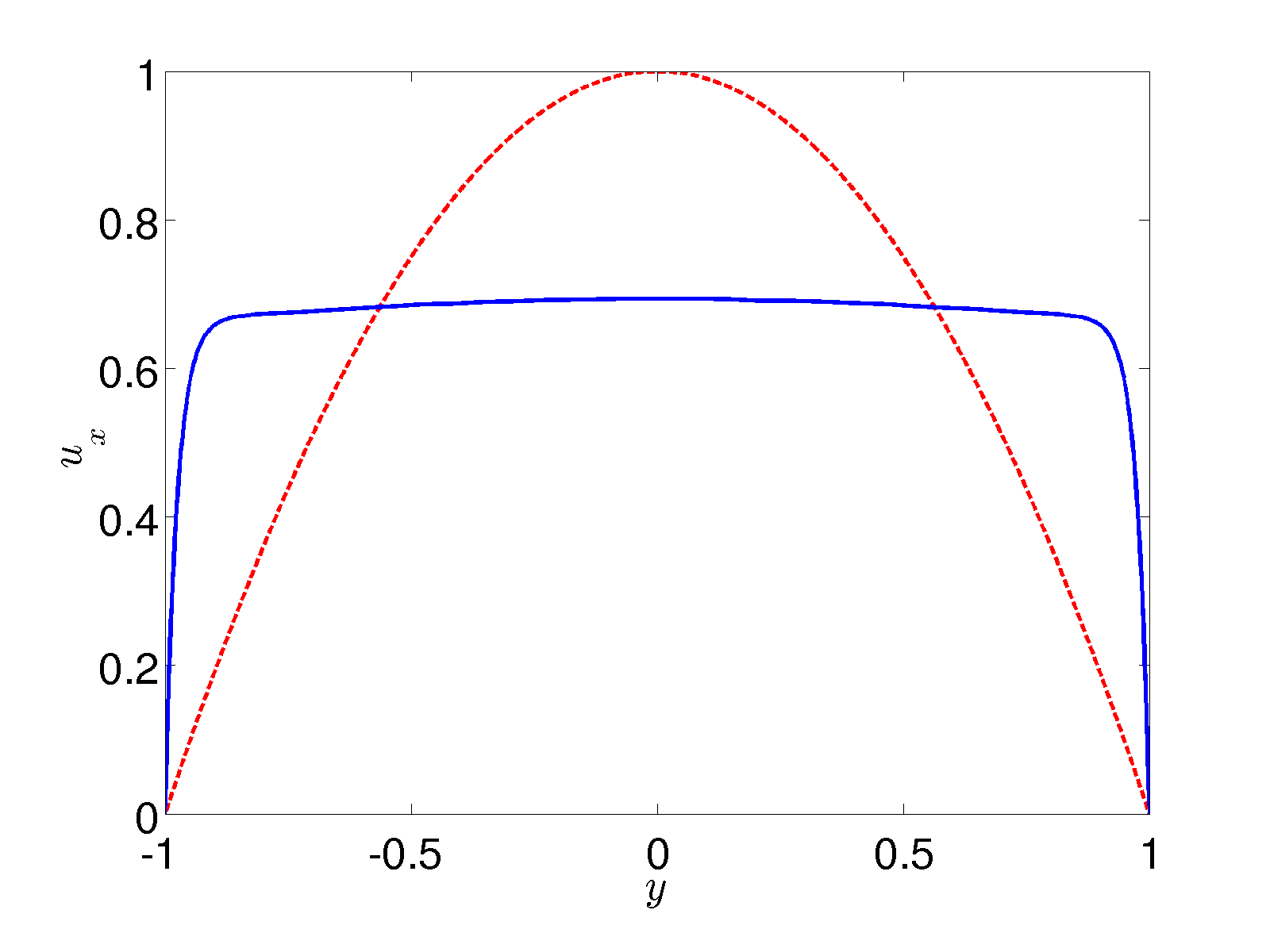 |
|
| Figure 4: Flow from an upper-convected Maxwell model with parabolic inflow at x=-1. Behind the inflow a boundary layer forms and the velocity profile can be described with an effective Navier-slip condition. | Figure 5: cross section through the velocity profile in Figure 4 at x=0.9 (blue full line) compared to the inflow (red dashed line) shows a significant boundary layer. | |
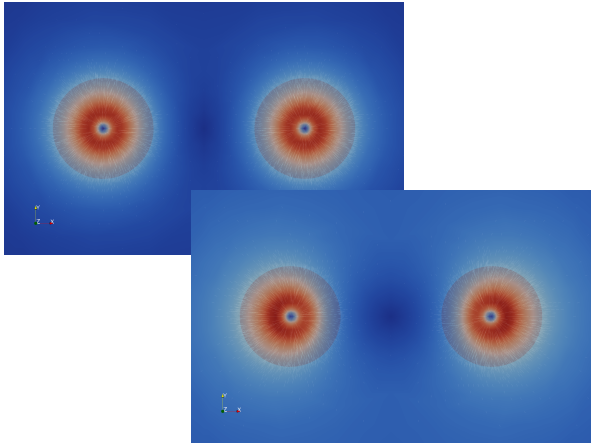 |
| Figure 6: Charged particles are shielded in a charged liquid (top=with charge, bottom=without charge) |
NOTE: Articles posted on this page are subject to copyright restrictions. They may be downloaded for personal use only. Any other use requires prior permission of the authors and the relevant publishers.
| [K10] | M. D. Korzec. Continuum modeling, analysis and simulation of the self-assembly of thin crystalline films. Ph.D. thesis, TU Berlin | PDF ABS |
| [KMW11] | M. D. Korzec, A. Münch and B. Wagner. Anisotropic surface energy formulations and their effect on stability of a growing thin film. submitted (also: Matheon preprint number 839 (2012).) |
|
| [MPPB12] | N. Murisic, B. Pausader, D. Peschka, A. L. Bertozzi. Dynamics of particle settling and resuspension in viscous liquids. submitted (Also WIAS preprint number 1679, (2012); Matheon preprint number 865, (2012)) |
|
| [KRW12] | G. Kitavtsev, L. Recke and B. Wagner. Asymptotics for the spectrum of a thin film equation in a singular limit. submitted (Also WIAS preprint number 1555, (2011)) |
|
| [KRN10] | M. D. Korzec, P. Rybka and P. Nayar. Global weak solutions to a sixth order Cahn-Hilliard type equation. submitted (Also WIAS preprint number 1581.) |
| [KW11] | G. Kitavtsev and B. Wagner. Coarsening dynamics of slipping droplets. J. Engin. Math., 66:271-292, 2010. (Also WIAS preprint number 1381.) |
|
| [KR10] | M. D. Korzec and P. Rybka. On a higher order convective Cahn-Hilliard type equation. (accepted for publication in SIAP) (Also WIAS preprint number 1582.) |
|
| [KRW11] | G. Kitavtsev, L. Recke and B. Wagner. Centre manifold reduction approach for the lubrication equation. Nonlinearity, 34:2347-2369, 2011. (Also WIAS preprint number 1554.) |
|
| [KPMWHS11] | K. Kostorou, D. Peschka, A. Münch, B. Wagner, S. Herminghaus and R. Seemann. Interface morphologies in liquid/liquid dewetting. Chemical Engineering and Processing: Process Intensification, 50:531-536, 2011. (Also WIAS preprint number 1560.) |
|
| [MW11] | A. Münch and B. Wagner. Impact of slippage on the morphology and stability of a dewetting rim. Journal of Physics: Condensed Matter, 23:184101, 2011. (Also WIAS preprint number 1556.) |
|
| [MPW11] | A. Münch, C. P. Please and B. Wagner. Spin coating of an evaporating polymer solution. Physics of Fluids, 23:1021101, 2011.(Also WIAS preprint number 1558.) |
|
| [KMN10] | D. Peschka, A. Münch and B. Niethammer. Self-similar rupture of viscous thin films in the strong-slip regime. Nonlinearity, 23, 2010.(Also WIAS preprint number 1418.) |
|
| [KE10] | M. D. Korzec and P. L. Evans. From bell shapes to pyramids: A reduced continuum model for self-assembled quantum dot growth. Physica D, 239(8): 465-474, 2010. Matheon preprint #583. (Also WIAS preprint number 1434.) |
PDF ABS |
| [K11] | M. D. Korzec. The effect of deposition in a model for quantum dot self-arrangement. PAMM, Proc. of GAMM 2011, 397.398, 2011. |
| [AMW07] | K. Afanasiev, A. Münch, and B. Wagner. On the Landau-Levich problem for non-Newtonian liquids. Phys. Rev. E, 76:036307, 2007. (Also WIAS preprint number 1215.) |
PDF ABS |
| [AMW08] | K. Afanasiev, A. Münch, and B. Wagner. Thin film dynamics on vertically rotating disks. Applied Mathematical Modelling, 32:1894-1911, 2008. (Also WIAS preprint number 1074.) |
PDF ABS |
| [BMRW06] | R. Blossey, A. Münch, M. Rauscher and B. Wagner. Slip vs. viscoelasticity in dewetting thin films. European Phys. J. E - Soft Matter, 20(3): 267-271, 2006. (Also WIAS preprint number 1192.) |
PDF ABS |
| [DW05] | W. Dreyer and B. Wagner. Sharp-interface model for eutectic alloys. Part I: Concentration dependent surface tension. Interfaces and Free Boundaries, 7(2):199-227, 2005. (Also WIAS preprint number 885.) |
PDF ABS |
| [EKM06] | P. L. Evans, J. R. King, and A. Münch. Intermediate-asymptotic structure of a dewetting rim with strong slip. AMRX Appl. Math. Res. Express, vol. 2006, Article ID 25262, 2006. |
PDF ABS |
| [EM06] |
P. L. Evans and A. Münch. Interaction of advancing fronts and meniscus profiles formed by surface-tension-gradient-driven liquid films. SIAM J. Appl. Math., 66(5):1610-1631, 2006. |
PDF ABS |
| [FMWRJ07] | R. Fetzer, A. Münch, B. Wagner, M. Rauscher and K. Jacobs. Quantifying hydrodynamic slip: A comprehensive analysis of dewetting profiles. Langmuir, 23(21):10559-10566, 2007. |
PDF ABS |
| [FRMWJ06] | R. Fetzer, M. Rauscher, A. Münch, B. Wagner, and K. Jacobs. Slip-controlled thin film dynamics. Europhys. Lett., 75(4):638-644, 2006. |
PDF ABS |
| [KMW09] | J. King, A. Münch, and B. Wagner. Linear stability analysis of a sharp-interface model for dewetting thin films. J. Engrg. Math., 63:177-195, 2009. (Also WIAS preprint number 1248.) |
|
| [KMW06] |
J. R. King, A. Münch, and B. Wagner. Linear stability of a ridge. Nonlinearity, 19:2813-2831, 2006. (Also WIAS preprint number 1070.) |
PDF ABS |
| [KW09] |
G. Kitavtsev and B. Wagner. Coarsening dynamics of slipping droplets. J. Engrg. Math., , 2009. (Also WIAS preprint number 1381.) |
PDF ABS |
| [KEMW08] | M. D. Korzec, P. L. Evans, A. Münch, and B. Wagner. Stationary solutions of driven fourth- and sixth-order Cahn-Hilliard type equations. SIAM J. Appl. Math., 69(2):348-374, 2008. Preprint arXiv:0712.2482v1 [math-ph] available at http://arxiv.org/abs/0712.2482 |
PDF ABS |
| [MW08] |
A. Münch and B Wagner. Galerkin method for feedback controlled Rayleigh-Benard convection. Nonlinearity, 21:2625-2651, 2009. (Also WIAS preprint number 907.) |
PDF ABS |
| [MWRB06] |
A. Münch, B. Wagner, M. Rauscher and R. Blossey.
A thin film model for corotational Jeffreys fluids under strong slip. European Phys. J. E, 20(4):365-368 2006. |
PDF ABS |
| [PMN09] |
D. Peschka, A. Münch and B. Niethammer. Thin film rupture for large slip. J. Engrg. Math., 66(1):33-51, 2010. (Also WIAS preprint number 1417.) |
PDF ABS |
| [RBMW08] |
M. Rauscher, R. Blossey, A. Münch and B Wagner. Spinodal dewetting of thin films with large interfacial slip: implications from the dispersion relation. Langmuir, 24: 12290-12294, 2008. (Also WIAS preprint number 1380.) |
PDF ABS |
| [Mue04] |
A. Münch. Fingering instability in dewetting films induced by slippage, 2004. |
PDF ABS |
| [WM04] |
B. Wagner and A. Münch. Galerkin approximation for Rayleigh-Bénard convection. Appeared in Nonlinearity (see above). (Also WIAS preprint number 907.) |
PDF ABS |
| [ESR05] | P. L. Evans, L. W. Schwartz and R. V. Roy. Three-dimensional solutions for coating flow on a rotating horizontal cylinder: theory and experiment. Phys. Fluids, 17(7):072102, 2005 |
PDF ABS |
| [FJMWW05] | R. Fetzer, K. Jacobs, A. Münch, B. Wagner, and T. P. Witelski. New slip regimes and the shape of dewetting thin liquid films. Phys. Rev. Lett., 95(12):127801, 2005. |
PDF ABS |
| [JAM05] | B. Jin, A. Acrivos, and A. Münch. The drag-out problem in film coating. Phys. Fluids, 17:103603, 2005 |
PDF ABS |
| [Mue05b] | A. Münch. Dewetting rates of thin liquid films. Journal of Physics: Condensed Matter, 17:S309-S318, 2005. |
PDF ABS |
| [ME05] | A. Münch and P. L. Evans. Marangoni-driven liquid films rising out of a meniscus onto a nearly horizontal substrate. Physica D, 209(1-4):164-177, 2005. |
PDF ABS |
| [MWW05] |
A. Münch, B. Wagner, and T. P. Witelski. Lubrication models with small to large slip lengths. J. Engrg. Math., 53(3-4):359-383, 2005. (Also WIAS preprint number 1069.) |
PDF ABS |
| [RMWB05] | M. Rauscher, A. Münch, B. Wagner, and R. Blossey. A thin-film equation for viscoelastic liquids of Jeffreys type. European Phys. J. E - Soft Matter, 17:373-379, 2005. |
PDF ABS |
| [ESR04] | P. L. Evans, L. W. Schwartz and R. V. Roy. Steady and unsteady solutions for coating flow on a rotating horizontal cylinder: Two-dimensional theoretical and numerical modeling. Phys. Fluids, 16(8): 2742-2756, 2004. |
PDF ABS |
| [MW04] | A. Münch and B. Wagner. Contact-line instability of dewetting thin films. Physica D, 209(1-4):178-190, 2005. |
PDF ABS |
| [Mue03] | A. Münch. Pinch-off transition in Marangoni-driven thin films. Phys. Rev. Lett., 91(1):016105, 2003. |
PDF ABS |
| [Mue02] | A. Münch. The thickness of a Marangoni-driven thin liquid film emerging from a meniscus. SIAM J. Appl. Math, 62(6):2045-2063, 2002. |
PDF ABS |